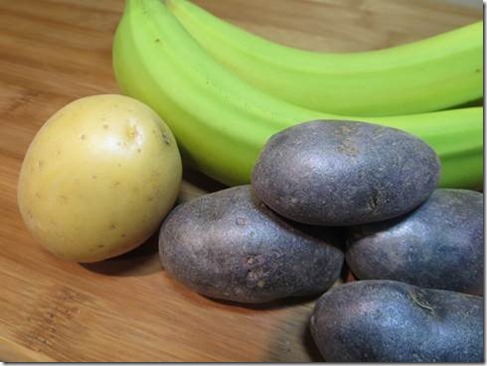Message to You from Your Friends Living in Your Colon, “Please Eat More Resistant Starch”

Are you interested in supporting your colon’s ability to fight cancer? How about trying to lose weight or maintain weight? What about managing your blood sugar? Food truly is medicine . . . . read more about foods that are sources of resistant starch to improve your health.
You help them and they help you. Need a little help from you friends? Even if you think you don’t you really do. By eating food sources of resistant starch you will benefit your health. Below you will find a list of sources of resistant starch and how they help your friendly gut microbes so they, in turn, can help you.
Humans need friendly bacteria in the colon to make short chain fatty acids (SCFAs).
Short chain fatty acids (SCFAs) are made by microbes that live in the colon. Here is how it works. We eat foods with resistant starch. Resistant starch cannot be broken down by digestive enzymes so this unique type of starch travels down the small intestine where it then enters the colon. Most of the microbes that live in the gut of humans reside in the colon. These friendly microbes use resistant starch as food; fermenting it, breaking it down and producing very beneficial SCFAs.
How do we benefit from SCFAs?
Friendly gut bacteria work to improve the health of the human gut and body. Here is a list based on current scientific evidence of how we benefit from the SCFAs produced by our beneficial microbes:
- Improve insulin sensitivity and help regulate blood sugar1, 3, 5
- Assist with improved bone health by helping absorb calcium and magnesium1
- Rev up the metabolism which helps with weight loss and weight maintenance1
- Improve the mucosal lining of the colon which is an important protective barrier2
- SCFAs are the preferred food for the cells that line the colon, keeping them healthy
- Decrease inflammation4
- Decrease risk of colon cancer by encouraging cancer cell death (apoptosis)4
- Decrease risk of non-alcoholic fatty liver disease (NAFLD) (animal study)5
- Shifts colon microbes toward more of the favorable friendly microbes and less of the harmful ones 6
- Improves iron absorption in the colon7
- May reduce oxidation and inflammation, impairing atherogenesis (heart disease)8
You can easily see from the list above why I was so inspired to write this blog and share this information with you. I care a lot about your health. What if you can improve your health by making some dietary improvements? Next I will give you a list of foods that are good sources of resistant starch that will feed your colon microbes and help you benefit from that great list. First, however, before you dive in I want to caution you!
Caution: ease into increasing resistant starch in your diet and don’t eat these foods every day (how about 3-4 times a week?).
I want to caution you about going overboard with resistant starch. Too much too fast can cause gas and bloating. Also, if you find that you can’t add any of the foods listed below, even in small amounts a couple of times a week, this could indicate you may have a conditiona called SIBO (small intestine bacterial overgrowth) and/or IBS (irritable bowel syndrome). If this is you please consider seeing me as a client for help as gastrointestinal problems are one of my specialty areas.
Examples of food sources of resistant starch:
List of food sources of resistant starch: raw potatoes, green bananas, plantains, cooked-and-cooled potatoes, cooked-and-cooled-rice, parboiled rice, and cooked-and-cooled legumes
Notice many of the items above say cooked-and-cooled. This is important. The resistant starch forms when items such as rice, potatoes or beans are cooled. Heat breaks down the resistant starch and then you won’t benefit from it. So, one idea is making potato salad. You could put cold beans on a salad, too. By the way, sweet potatoes do not have much resistant starch, but the purple potatoes pictured above are a good source.
List of supplementary isolated starch sources of resistant starch: raw potato starch, plantain flour, green banana flour, and cassava/tapioca starch
From the list above, the easiest source of isolated starch is raw potato starch. One brand I like is Bob’s Red Mill. If you decide to try potato starch or any of the starches listed above remember to start with a very small amount and gradually build up.
Two more important tips:
- Life is not static nor should our dietary intake be. We easily get in food ruts. We tend to thrive when we vary up our food intake. Try adding a little resistant starch to your dietary pattern from the list above. One week you might eat a green banana and a small amount of leftover cold rice. The next week make a point to eat some cooked and chilled black beans.
- If you are having trouble with gas you might try this: buy a can of organic pinto beans. Every day for two weeks eat about 1-2 tablespoons of cold pinto beans. Pinto beans are the easier bean to digest. This will begin to gradually help your healthy colon microbes increase and adapt to more fiber in your diet. Then you should be able to switch to other beans from the legume family and try other foods rich in resistant starch.
Your friendly gut microbes say, “thank you!”
Please leave a comment below letting me know if this blog provided you with helpful information.
~Tracey
For a list of references I used in this article click HERE.




You might be interested to know that the FDA approved a claim that resistant starch helps to reduce the risk of type 2 diabetes. They concluded that the evidence was limited and inconsistent, but was valid. For more information, see http://resistantstarchresearch.com/posts/fda-announces-health-claim-for-resistant-starch/. This is a tremendous accomplishment given that 35% of American adults are prediabetic.
Thank you for sharing this research! Recently I have started recommending that my diabetic clients with high morning blood sugar and/or blood sugar dips during the night eat a snack with resistant starch and a little protein and healthy fat at bedtime. The resistant starch-based snack seems to help stabilize blood glucose overnight.